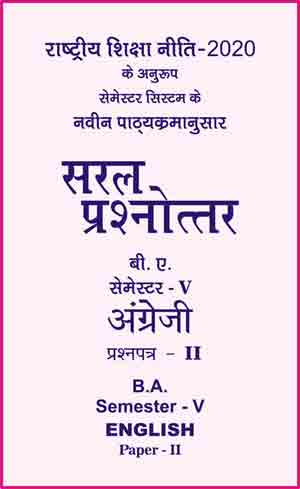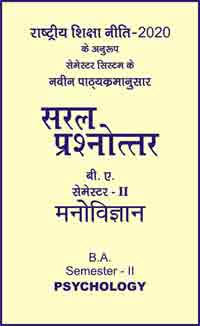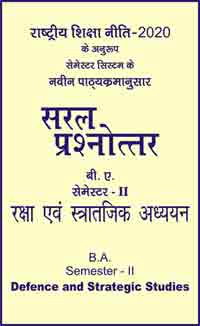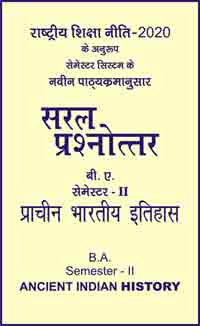|
बी ए - एम ए >> बीए सेमेस्टर-5 पेपर-2 अंग्रेजी बीए सेमेस्टर-5 पेपर-2 अंग्रेजीसरल प्रश्नोत्तर समूह
|
5 पाठक हैं |
|||||||
बीए सेमेस्टर-5 पेपर-2 अंग्रेजी - सरल प्रश्नोत्तर
Question- Write a note on the development of English novel up to Dickens.
Answer-
In the 16th century, there was considerable activity in many kinds of prose fiction. John Lyly's Euphues' (1578) is a romantic intrigue told in elegant letters. It contains general discussions on such topics as religion, love and epistolary style. Lyly's main interest is not narrative or psychological but educational. In 'Arcadia' Sidney tells a very long and complicated story of separated noble lovers, disguises, oracles, love philters and hair breadth escapes. The same emphasis on complicated adventure is found in many prose narratives, under the Stuarts, prose fiction continued along the established traditions of the picaresque novel, the romance and the Novella. Apart from Congreve's 'Incognita' there is little in 17th century prose fiction of note except Bunyan's contribution. 'Grace Abounding to the Chief of Sinners' is in the established Puritan form of the autobiographical confession. The subject of 'Pilgrim's Progress' is similar. "The Life and Death of Mr. Badman" depicts 'graphic realism'.
The English novel emerged first in the 18th century. In this era Defoe, Richardson, Fielding, Smollett, Sterne and Goldsmith reflected life as it is in the form of story. The main factors, for the rise of English novel are, rise of the middle class, the rise of reading public, rise of the democratic government, the rise of the periodical essay and the decline of the drama. Defoe reflected the strong secularizing tendency of his time. He presented his pretendedly, genuine autobiographical memories 'Robinson Crusoe', 'Moll Flanders', "The History of Colonel Jack' and 'Roxana'. These are vivid and comprehensive expressions of the social and economic individualism of the protestant ethic. In form, they are loosely episodic biographies of heroes or heroines for whom the quest for middle class security is the most compelling reality. His journalistic training enabled him to make his fiction literally convincing. He introduced into the tradition of the novel of its most enduring themes the struggle of the individual both with the external world and with his own conscience.
Samuel Richardson's novels are in the main fictional patterns. His 'Pamela' or "The Virtue Rewarded' seems to be a unified novel. 'Pamela's great extension in psychological depth continued in 'Clarissa' or 'the History of a Young Lady. It is the first and one of the greatest of tragic novels. In the 'History of Sir Charles Grandison', Richardson used the epistolary method for a less intense kind of social and moral analysis. Fielding's 'Joseph Andrews' is a lively comic story about the travels. "Tom Jones' is a panaromic novel. It reveals Fielding's ethical and social views. His 'Amelia' is a more sombre treatment of the consequences of material fidelity and weakness. Smollett in 'Roderick Random', "The Adventures of Fieregrive Prickle' and other novels of which the best is 'Humphry Clinker' developed the primarily comic and satiric novel along picaresque. Sterne wrote "The Life and Opinions of Tristam Shandy' and 'Sentimental Journey. In these novels the sentimental note reaches the extreme limits of its principle. The history of the English novel in the 18th century after Richardson, Fielding, Smollett and Sterne, is the story of its disintegration. With the solitary exception of Goldsmith's The Vicar of Wakefield', no good novel was published. Le Sage's 'Gil Bilas' Marivan's 'Marianne', Abbe Prevost's 'Cleveland', Rosseau's 'Heloise' supplied models for cheap writers. Sarah Fielding, Mrs. Lennox, Mrs. Sheridan, Mrs. Brooke, Mrs. Griffeth wrote novels in profusion, novels of domestic manners or romantic adventure.
The Gothic novel as originated by Horace Walpole in 'Castle of Ofranto' and practised by Ms. Anne Radcliffe in 'A Sicilian Romance', "The Romance of the Forest' "The Mysteries of Udolpho' Clara Reeve. (The old English Baron), Mrs. Charlotte Smith (The Old Manor House) and Matthew Gregory Lewis (The Monk) deserve mention. These writers revealed the growing taste of writers and readers alike for strong appeals to the emotions.
In the romantic period, Sir Walter Scott's interest in the past brought about the historical novel. Some of his historical novels are 'Waverly' 'Old Morality', 'Roy Roy'. "The Heart of Midothian, "The Bride of Lammer moor', The Monastery "The Abbot', 'Knilworth', "The Private', The Fortune of the Nigel', 'Poveril of Peak', and Quentin Durward'. Jane Austen described her own time and scenes in 'Pride and Prejudice', 'Mansfield Park', 'Emma' and 'Persuasion'. She initiated one of the greatest and most characteristic traditions of the English novel, that of familiar domestic comedy.
During the reign of Queen Victoria the novel became the dominant literary genre. Dickens was a reformer in everything he wrote. He attacked a multitude of social, political, administrative and economic evils. We observe melodramatic over simplification of goodness and badness in Nicholas Nickleby', 'The sentimentalism of The Old Curiosity Shop', insular and unhistorical bias of A tale of two cities'. 'Martin Chuzzlewit', David Copperfield' 'Bleak House' and 'Great Expectations' provide a comprehensive, personal and enduring vision of the world. George Eliot, Thackeray, Emil Pronte, George Meredith and Thomas Hardy are other great Victorian novelists of real interest and importance. Almost all the Victorian novelists. reflect some or the other social aspect in their novels. Dickens did much to idealise the England of his time and he depicted the lower and middle classes with imagination and humour. As a satirist and observer of manners Thackeray easily excels his contemporaries. Charlotte Bronte supplied a sombre passion that coloured the drabness of her life. Trollope specialised. with his persons. Collins wrote mystery stories of the rest. George Eliot showed a closeness of application to the mental processes of her characters. that was further carried in the work of Meredith. Reade's novels deal with the horrible conditions in prisons and lunatic asylyms.
|
|||||
- Question- Discuss in detail the development of English novel from the eighteenth century to the Modern Age.
- Question- What do you understand by Novel? What are the elements which are to considered in plot construction.
- Question- Write a note on characterization of a novel. How much is it important for development of a novel?
- Question- Write a short note on narrative technique of a novel.
- Question- Write a note on the elements of a short story.
- Question- Write a note on Fielding's plot construction.
- Question- Write a note on Fielding's characterisation.
- Question- Define plot. What are the qualities of an ideal plot ?
- Question- Write a short note on the plot construction of a novel.
- Question- What is the difference between Flat Character and Round Character?
- Question- Write a short note on the characterization of a novel.
- Question- Write a short note on narrative technique of a novel.
- Question- What is a short story? What is the difference between a short story and a novel?
- Question- What is a picaresque novel? Who are the main exponents of the picaresque novel?
- Question- What is a historical novel? What is the difference between history and a historical novel? Name a few historical novelists and their creation.
- Question- What do you know about the Gothic novel?
- Question- Write a note on Epistolary novel.
- Question- Write a note on the Regional novel.
- Question- Point out the chief characteristics of the Picaresque novel.
- Question- Point out the chief characteristics of the historical novel.
- Question- Write an essay on Sir Walter Scott's contribution to historical novel.
- Question- Point out the chief characteristics of Gothic novel.
- Question- Point out the chief characteristics of the Regional novel.
- Question- What is a regional novel? Name a few novelists of this genre and their novels.
- Question- What is a Picaresque novel?
- Question- What do you know about Historical novel?
- Question- What do you know about Gothic novel?
- Question- Examine the merits of Sir Walter Scott as a Historical novelist.
- Question- What do you mean by domestic novel?
- Question- What do you mean by the Stream of consciousness? Who. coined the term?
- Question- What is a Epistolary novel?
- Question- What do you know about the Regional novel?
- Question- Trends in 20th and 21st Century Fiction Discuss as a sub-genre of crime fiction and mystery.
- Question- Define utopian fiction. Discuss its history and origin.
- Question- What is campus novel? Explain its history and development.
- Question- Write a note on Detective novel.
- Question- Write a note on Science fictions.
- Question- Write a note on Meta fiction.
- Question- Define mythology. Explain the rise of mythological fiction in India.
- Question- What is space fiction? Discuss its characteristics and example.
- Question- Define chick lit. Discuss its characteristics and example.
- Question- Define junk fiction. Explain its characteristics and types of junk fiction.
- Question- Write a short note on detective novel.
- Question- Write short note on Science fiction.
- Question- What is Meta fiction?
- Question- What is Science Fiction?
- Question- What is utopian fiction?
- Question- Why are campus novels important? What kind of characters are in campus novels?
- Question- What is dystopian fiction?
- Question- Discuss feminism in mythological fiction.
- Question- Why are campus novels important? What kind of characters are in campus novels?
- Question- What is chic lit fiction?
- Question- Write a note on the life and works of Charles Dickens.
- Question- Write a note on Charles Dickens as a novelist.
- Question- Write a note on the development of English novel up to Dickens.
- Question- Write a note on Dicken's social criticism. What was Dickens' attitude toward various social evils of the day?
- Question- Describe Dickens as a representative of his age.
- Question- Write a note on Dickens as a social reformer.
- Question- Write a note on the social background of Dickens.
- Question- Write a note on Dickens's contribution to English novel.
- Question- Discuss symbolism as a structural elements in A Tale of two cities.
- Question- Discuss Dickens's art of characterization in the novel "A Tale of Two Cities".
- Question- What is meant by criticism of life? What is the 'vision of life"? Point out the criticism and vision of life in A Tale of Two Cities.
- Question- Write a note on the blend of realism and idealism in the novels of Dickens.
- Question- "Dickens' characters are both types and individuals.” Discuss.
- Question- Write a note on Dickens as a satirist.
- Question- What is the significance of the name "Jacques" in A Tale of Two Cities?
- Question- In Book 2, Chapter 21 of A Tale of Two Cities, what is happening in France that upsets Mr. Jarvis Lorry?
- Question- Write the life of Thomas Hardy and about his career.
- Question- What are the three phases of Hardy's writing? What were the issues he dealt with in those three phases?
- Question- Write short notes on the major characters of the novel, and show how Hardy develops these characters in the course of the novel.
- Question- Who is the heroine of 'Far From the Madding Crowd"? How doy o you justify her position as the heroine?
- Question- Explain the tragic vision of Hardy in Far From the Mad ding Crowd.
- Question- Why does Bathsheba reject Gabriel's proposal at the start of the novel?
- Question- How is sexual desire portrayed in the novel?
- Question- How was Oak's life saved by Bathsheba?
- Question- How was Oak completely ruined?
- Question- Describe the feast after sheep-shearing.
- Question- How are Oak and Bathsheba ultimately a happy couple?
- Question- Discuss Jane Austen as a realist.
- Question- Point out Jane Austen's contribution to the English novel.
- Question- Write a note on characterisation of Jane Austen with special reference to 'Pride and Prejudice'.
- Question- Is there artistic detachment in Jane Austen ? Write a brief note in support to your view with illustrations.
- Question- Sketch the character of Fitzwilliam Darcy.
- Question- Sketch the character of George Wickham.
- Question- Do you agree with the view that the novel 'Pride and Prejudice' revolves around two themes of 'Pride and Prejudice'? Give reasons for your answer?
- Question- Write an essay on the sequence of events in 'Pride and Prejudice'?
- Question- Write a note on Life Sketch of George Eliot Life Sketch of George Eliot
- Question- Discuss the humour elements in George Eliot's The Mill on the Floss.
- Question- Critically examine the artistic and the philosophic dimensions of the ending of The Mill on the Floss in the light of the view of the individual and society presented in the novel.
- Question- Compare and contrast Maggie's love for Philip, Stephen, and Tom.
- Question- Describe the thematic import of Maggie's decision to relinquish Stephen.
- Question- Compare and contrast Tom and Maggie. How much are their respective successes and failures a function of gender and how much a function of their distinct characteristics?
- Question- Compare and contrast Tom and Mr. Tulliver. Why does Tom succeed where Mr. Tulliver failed?
- Question- Write a note on life kketch of Toni Morrison.
- Question- Discuss the narrative strategies used by the writer in The Bluest Eye.
- Question- Discuss the narrative structure of the novel. Why might Morrison have chosen to present the events in a non- chronological way?
- Question- What does the title of The Bluest Eye mean?
- Question- How are Pecola Breedlove and Maureen Peal foils to one another?
- Question- The Bluest Eye uses multiple narrators, including Claudia as a child, Claudia as an adult, and an omniscient narrator. Which narrative point of view doyou think is most central to the novel and why?
- Question- Who do you think is the most sympathetic character in the novel and why?
- Question- The Bluest Eye is a novel about racism, and yet there are relatively few instances of the direct oppression of black people by white people in the book. Explain how racism functions in the story.
- Question- Write a note on Life Sketch of The Harper Lee.
- Question- Analyze the childhood world of Jem, Scout, and Dill and their relationship with Boo Radley in Part One.
- Question- What is Atticus's relationship to the rest of Maycomb? What is his role in the community?
- Question- Discuss the role of family in To Kill a Mockingbird, paying close attention to Aunt Alexandra.
- Question- Discuss the author's descriptions of Maycomb. What is the town's role in the novel? Analyze the author's treatment of Boo Radley. What is his role in the novel?
- Question- Discuss Atticus's parenting style. What is his relationship to his children like? How does he seek to instill conscience in them?
- Question- Identify Atticus Finch, Jean Louise (Scout) Finch, Jem Finch, Maycomb, Calpurnia, Charles Baker (Dill) Harris, The Radley Place, Stephanie Crawford, Arthur (Boo) Radley, Miss Caroline Fisher, Walter Cunningham, and Burris Ewell.
- Question- Why did Mr. Cunningham's mob leave?
- Question- In Chapter 2 of To Kill a Mockingbird what does Miss Caroline, Scout's first-grade teacher, represent?
- Question- In Chapter 6 of To Kill a Mockingbird why is Jem is determined to retrieve his pants from the fence despite the danger of meeting up with Nathan Radley?
- Question- What is the significance of the title To Kill a Mockingbird according to Atticus's reasoning in Chapter 10?
- Question - Comment upon the role of the lions in The Old Man And The Sea.
- Question- Comment upon the symbolic role played by Di Maggio in the novel "The Old Man And The Sea'...
- Question- Comment upon the arm-wrestling episode in the novel 'The Old Man and The Sea'.
- Question- Comment upon the marlin separating episode in the novel "The Old Man and The Sea".
- Question- Write a note on the major themes of the novel The Old Man and The Sea'.
- Question- Write a brief note on The Old Man And The Sea' as a tragedy.
- Question- Which claims your attention more in The Old Man And The Sea' its narrative or allegory?
- Question- The hero of the novel "The Old Man And The Sea' is really a Christfigure. Comment.
- Question- Write a brief note on Hemingway hero or the autobiographical hero.
- Question- In the fight of the old man against the giant fish what we see is a "battle of attrition". Comment.
- Question- Write a note on Life Sketh of John Ernst Steinbeck.
- Question- Analyze Tom Joad's growth throughout the novel. Despite the fact that Tom is not a young boy, does the novel have the characteristics of a bildungsroman, or coming-of-age story?
- Question- Discuss the development of Tom Joad as a character. How does he grow throughout the book? What effects do Jim Casy's imprisonment and death have on his development?
- Question-What themes related to family are in The Grapes of Wrath?
- Question- How does the erosion described in Chapter 1 of The Grapes of Wrath relate to the Bank monster described in Chapter 5?
- Question- How do the roles of Ma and Pa differ in the Joad family in The Grapes of Wrath?
- Question- In The Grapes of Wrath how is the Gila monster described in Chapter 13 comparable the Bank monster?
- Question- What biblical allusions does John Steinbeck include in The Grapes of Wrath and how does he use them?
- Question- How do the roles of Ma Joad and Pa Joad within the family change in The Grapes of Wrath?
- Question- In The Grapes of Wrath, why does the Joad family deteriorate after the Joads leave Oklahoma?
- Question- Write a note on Life Sketch of Aravind Adiga
- Question- Discuss plot of the novel The White Tiger.
- Question- Explain literary analysis of The White Tiger by Aravind Adiga.
- Question- Critical analysis of the novel The White Tiger written by Aravind Adiga.
- Question- What is Balram's attitude toward religion? How does this develop throughout the novel?
- Question- How does this portrayal of India differ from more typical literary depictions of India?
- Question- Why does Balram choose to address his narrative to the Premier of China? How would the story have been different without this framing device?
- Question- Discuss Balram's many names throughout the novel, and how each one represents an aspect of him.
- Question- What does Balram's experience in Bangalore reveal about the Indian economy in an increasingly globalized world?
- Question- Attempt critical analysis of the novel 'Dalits, Dynasty and She' by Sanjay Chitranshi.
- Question- Explain the plot of the novel 'Dalits, Dynasty and She 'written by Sanjay Chitranshi.
- Question- Discuss the Novel 'Dalits, Dynasty and She' by Sanjay Chitranshi.
- Question- Who was Shanti Devi?
- Question- Write a' character sketch of Ram Chandra.
- Question- Write a note on Life Sketch of Sudha Murty.
- Question- What are the major themes of the novel "Dollar Bahu"?
- Question- Discuss how the notion of self sacrifice is exclusively attributed to a particular gender in Indian society. How they thrive through the difficult situation in life when they are implanted to a new atmosphere.
- Question- Write a note on the title "Dollar Bahu?".
- Question- Write a note on the end of the novel "Dollar Bahu".
- Question- Discuss the central theme of Dollar Bahu.














